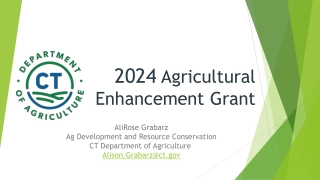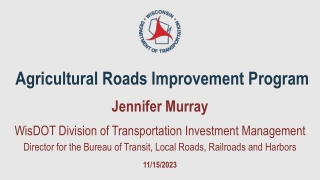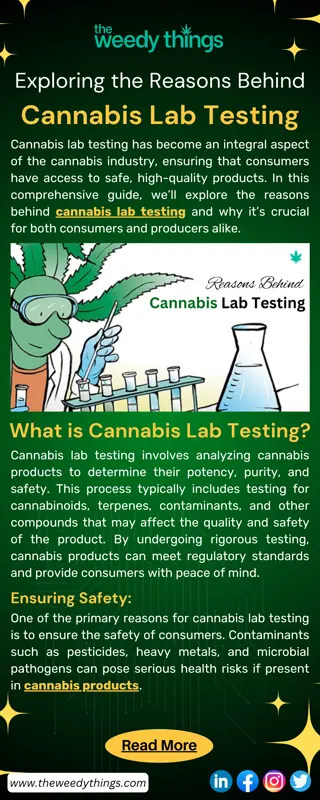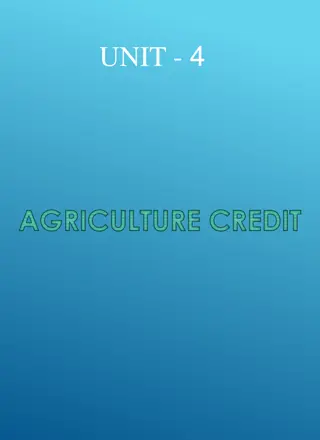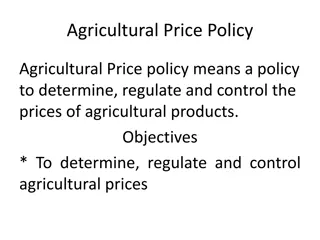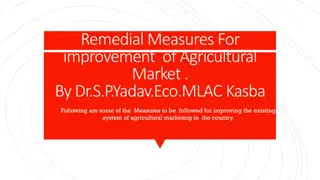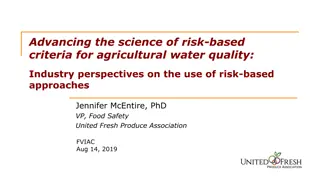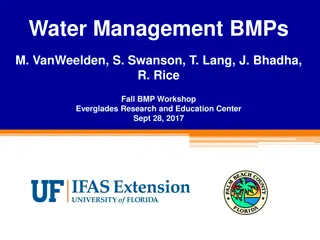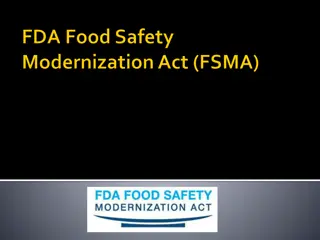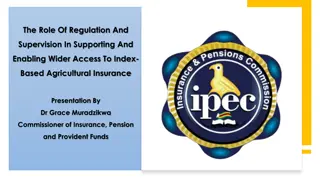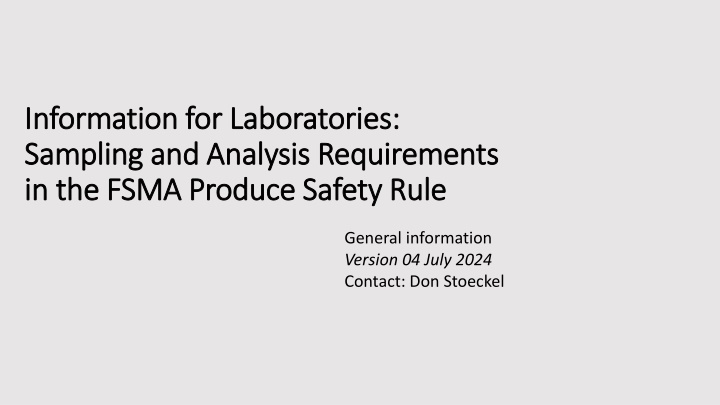
Laboratory Sampling and Analysis Requirements in FSMA Produce Safety Rule
Understand the sampling and analysis requirements in the FSMA Produce Safety Rule, emphasizing the importance of testing water quality, meeting buyer requirements, and complying with FSMA regulations. Get insights on pre-harvest agricultural water requirements and how growers can minimize risks to their crops through water management practices.
Download Presentation

Please find below an Image/Link to download the presentation.
The content on the website is provided AS IS for your information and personal use only. It may not be sold, licensed, or shared on other websites without obtaining consent from the author. If you encounter any issues during the download, it is possible that the publisher has removed the file from their server.
You are allowed to download the files provided on this website for personal or commercial use, subject to the condition that they are used lawfully. All files are the property of their respective owners.
The content on the website is provided AS IS for your information and personal use only. It may not be sold, licensed, or shared on other websites without obtaining consent from the author.
E N D
Presentation Transcript
Information for Laboratories: Information for Laboratories: Sampling and Analysis Requirements Sampling and Analysis Requirements in the FSMA Produce Safety Rule in the FSMA Produce Safety Rule General information Version 04 July 2024 Contact: Don Stoeckel
Background Slides prepared for a commercial laboratory test supplier Shared here for use by educators to help laboratories understand produce farm needs Accurate to the best of my ability to know Not guaranteed, you should also do your own research and self-education on the topic Main Points Produce growers and packers are encouraged to test their water Understand sanitary quality Meet buyer requirements (e.g., third-party food safety audits) Compliance with FSMA Produce Safety Rule (PSR) requirements Produce growers and packers may need help identifying The tests they need Labs that can perform these tests using accepted methods Laboratories are one source of information for produce growers and packers Information in this resource provides information for laboratories to use with farm clients Compiled by Don Stoeckel Version July 04, 2024 Images, text NOT in PSA Grower Training Course stock materials SUPPLEMENTAL MATERIAL
The Food Safety Modernization Act (FSMA) FSMA is administered by FDA and currently includes: Produce Safety Rule (2015) Pre-Harvest Agricultural Water Amendments (2024) Preventive Controls for Human Food (2015) Preventive Controls for Animal Food (2015) Foreign Supplier Verification Programs (2015) Food Traceability Rule (2022) Accreditation of Third-Party Auditors/Certification Bodies (2015) Laboratory Accreditation for Analysis of Foods (2021) Sanitary Transportation of Human and Animal Food (2016) Prevention of Intentional Contamination/Adulteration (2016) Focused on prevention of food safety issues and encompasses the entire food system Compiled by Don Stoeckel Version July 04, 2024 Images, text NOT in PSA Grower Training Course stock materials Revised Module 5-1 (Version 1.2a) Slide Content Adapted from PSA Grower Training SUPPLEMENTAL MATERIAL
Pre-Harvest Agricultural Water Requirements Recently Amended (non-sprout covered produce) FDA published a Revision to Subpart E: Agricultural Water on May 06, 2024 (QR code and URL below) https://www.fda.gov/food/food-safety-modernization- act-fsma/fsma-final-rule-pre-harvest-agricultural-water The revised Subpart E moves from decision making based on testing pre-harvest water to use of an agricultural water assessment of the whole water system Each grower needs to understand their water quality and how their water management practices minimize risks to the crops they grow. Should be prepared to explain during inspectional visits This understanding can include water test results Compiled by Don Stoeckel Version July 04, 2024 Images, text NOT in PSA Grower Training Course stock materials Revised Module 5-1 (Version 1.2a) Slide Content Adapted from PSA Grower Training SUPPLEMENTAL MATERIAL
Agricultural Water Sampling and Analysis Information Compiled by Don Stoeckel Version July 04, 2024 Images, text NOT in PSA Grower Training Course stock materials SUPPLEMENTAL MATERIAL
Produce Safety Rule Water Testing Requirements Water Use Pre-Harvest (non-sprout covered produce) Generic E. coli OR Any other scientifically valid indicator 100 mL Any, if scientifically valid EPA RWQC can be used** USEPA Method 1603 OR Equivalent Postharvest (unchanged in 2024) Generic E. coli Sprouts* (unchanged in 2024) Analyte Generic E. coli (all agricultural water) E. coli O157:H7, Salmonella (spent water) Listeria spp. or mono (environmental) 100 mL (E. coli) or 375 mL (Salmonella) Not detected in volume (or mass) tested; often 100 mL USEPA Method 1603 OR equivalent FDA methods referenced OR equivalent Volume Standard 100 mL Not detected in 100 mL Method USEPA Method 1603 OR Equivalent *Sprout growers are supported with a training course maintained by the Sprout Safety Alliance at Illinois Institute of Technology s Institute for Food Safety and Health: https://www.iit.edu/ssa See also Sprout Safety Alliance presentation that describes requirements for water used to grow sprouts: https://www.aphl.org/courses/Documents/2019/100-613-19%20Webinar_Ag%20Water_Complete_slides.pdf ** USEPA Recreational Water Quality Criteria of 126 CFU/100 mL geometric mean, 410 CFU/100 mL statistical threshold value are accepted by FDA in the context of a 20-sample, 2-to-4-year rolling data set called the Microbial Water Quality Profile Compiled by Don Stoeckel Version July 04, 2024 Images, text NOT in PSA Grower Training Course stock materials SUPPLEMENTAL MATERIAL
Summary: Pre-Harvest Agricultural Water Assessment Animated version at: foodsafetyclearinghouse.org/node/1505 Agricultural Water Systems Inspection (all ag water) 112.42 Immediately discontinue use Corrective Measures Measures needed because not safe or not of adequate sanitary quality 4 Assessment Determinations Agricultural Water Assessment (pre-harvest ag water) 112.43 Information Measures needed because of conditions that ARE RELATED to animal activity, BSAAO, or human waste on adjacent and nearby land Promptly implement Mitigation Measures Measures and Timing 112.45 Agricultural Water System(s) 5 Elements May include TESTINGas an other relevant factor in assessment Measures needed NOT RELATED to conditions above Agricultural Water Practices OR Crop Characteristics As soon as practicable implement Mitigation Measures Environmental Conditions No measures needed Document decision to use water Reassess as needed Other Relevant Factors Results of TESTING included here Compiled by Don Stoeckel Version July 04, 2024 Images, text NOT in PSA Grower Training Course stock materials SUPPLEMENTAL MATERIAL
Pre Pre- -Harvest Harvest Water Test Analyte Requirement (non sprout) If testing is done in support of an agricultural water assessment, the default analyte is generic E. coli Broad flexibility for other scientifically valid analytes (Comment 90 from preamble, 2024 Revised PSR Subpart E) EPA 2012 Recreational Water Quality Criteria alternate indicators are examples If testing for any other analyte, no requirement to also test for generic E. coli. No requirement to notify or seek approval from FDA Scientifically valid described as an approach that is based on scientific information, data, or results published in, for example, scientific journals, references, text books, or proprietary research 112.43(d)(2) The sample(s) must be tested for generic Escherichia coli (E. coli) as an indicator of fecal contamination (or for another scientifically valid indicator organism, index organism, or other analyte). Compiled by Don Stoeckel Version July 04, 2024 Images, text NOT in PSA Grower Training Course stock materials SUPPLEMENTAL MATERIAL
Pre Pre- -Harvest Harvest Water Test Criteria Requirement (non sprout) If testing is done, there is no quantitative standard in regulation Any criterion must be scientifically valid and appropriate FDA describes the (2015 Produce Safety Rule) Microbial Water Quality Profile as scientifically valid and appropriate for purposes of 112.43(d) (Comment 93 from preamble, 2024 Revised PSR Subpart E) For surface water, a set of 20 or more results representing 2-4 years of sampling Criteria same as EPA RWQC: Geometric mean 126 CFU/100 mL or less; statistical threshold value 410 CFU/100 mL or less 112.43(d)(3) The frequency of testing samples and any microbial criterion (or criteria) applied must be scientifically valid and appropriate to assist in determining, in conjunction with other data and information evaluated under paragraph (a) of this section, whether measures under 112.45 are reasonably necessary to reduce the potential for contamination of covered produce (other than sprouts) or food contact surfaces with known or reasonably foreseeable hazards associated with your agricultural water used in growing covered produce (other than sprouts) Compiled by Don Stoeckel Version July 04, 2024 Images, text NOT in PSA Grower Training Course stock materials SUPPLEMENTAL MATERIAL
2015 Pre Profile Criteria Calculations Pre- -Harvest Harvest Microbial Water Quality Spreadsheets and extension documents help with calculation of geometric mean and statistical threshold value, if needed Publicly-Available Calculator Tools wcfs.ucdavis.edu/ agwater.arizona.edu/ agwater.arizona.edu/onlinecalc/ Produce Safety Alliance Fact Sheet https://cals.cornell.edu/ produce-safety-alliance/resources Compiled by Don Stoeckel Version July 04, 2024 Images, text NOT in PSA Grower Training Course stock materials SUPPLEMENTAL MATERIAL
Postharvest Postharvest Water Testing No analyte other than generic E. coli allowed No standard other than not detected in 100 mL allowed Do not test untreated surface water for postharvest use May not be used, even if it test shows no detectable generic E. coli in 100 mL Farms may be motivated to test ground water used for pre-harvest using presence/absence methods to meet an exemption Water sources that meet postharvest requirements are exempt from the pre- harvest agricultural water assessment see (2024) 112.43(b)(1) 112.44(a) Microbial quality criterion. When you use agricultural water for any one or more of the following purposes, you must ensure there is no detectable generic Escherichia coli (E. coli) in 100 milliliters (mL) of agricultural water, and you must not use untreated surface water for any of these purpose. {sprouts, during harvest or postharvest, food-contact surfaces, hand washing} Compiled by Don Stoeckel Version July 04, 2024 Images, text NOT in PSA Grower Training Course stock materials SUPPLEMENTAL MATERIAL
Generic E. coli Water Test Method Requirement FDA Fact Sheet Equivalent Testing Methodology for Agricultural Water Produce Safety Rule includes 15 methods Quantitative: Eight named methods plus EPA Method 1603 (Modified mTEC) Presence/Absence: Six named methods For any analyte other than generic E. coli, the measurement method must be scientifically valid 112.151 You must test the quality of water using: (a) The method of analysis published by the U.S. Environmental Protection Agency (EPA), Method 1603: Escherichia coli (E. coli) in Water by Membrane Filtration Using Modified membrane-Thermotolerant Escherichia coli Agar (Modified mTEC), EPA-821-R-09-007), (b)(1) A scientifically valid method that is at least equivalent to the method of analysis in 112.151(a) in accuracy, precision, and sensitivity; or (b)(2) For any other indicator of fecal contamination, index organism, or other analyte you may test for pursuant to 112.43(d), a scientifically valid method. Compiled by Don Stoeckel Version July 04, 2024 Images, text NOT in PSA Grower Training Course stock materials SUPPLEMENTAL MATERIAL
List of Equivalent Methodologies to Method 1603 Quantitative (suitable for pre-harvest or postharvest) Membrane filtration methods (colony forming units, CFU/100 mL) mTEC agar (EPA 2010, APHA 2012, ASTM 2000) mColiBlue PourRite Ampules (Hach method 10029) mEndo followed by NA-MUG agar (APHA 1997) MI agar (EPA 2012) Most Probable Number (MPN/100 mL) methods Colilert (using Quantitray 2000 tray) Colilert 18 (using Quantitray 2000 tray) Presence-Absence (most suited to postharvest) Broth-based methods for detection in 100 mL water TECTATM EC/TC medium and the TECTATM Instrument Modified ColitagTM Test method IDEXX Colilert, Colilert 18, and Colisure Charm Sciences E*Colite Bag or Vial Test Millipore Readycult Coliforms 100 Compiled by Don Stoeckel Version July 04, 2024 Images, text NOT in PSA Grower Training Course stock materials Revised Module 5-1 (Version 1.2a) Slide Content Adapted from PSA Grower Training SUPPLEMENTAL MATERIAL
Suggestions for Laboratories Dilute if needed for log-scale calculations: You cannot calculate a GM and STV with greater than results Annotate methods when needed: Example: Standard Methods 9223 B can be done using several products FDA staff note that citing only SM 9223 B is ambiguous for compliance SM 9223 B using Colilert or Colilert-18 with Quantitray 2000 are the quantitative methods listed in the FDA fact sheet; any others are not listed For labs that handle agricultural water, pursue listing on the national map of analysis laboratories (discussed later) For presence/absence tests, be explicit about when a result means not detected in 100 mL water Record both total coliform and E. coli results for any dual methods The FSMA Produce Safety inspector may find it easiest to see generic E. coli results Compiled by Don Stoeckel Version July 04, 2024 Images, text NOT in PSA Grower Training Course stock materials SUPPLEMENTAL MATERIAL
Timing and Location of Sampling Labs should not recommend sampling schedules based only on typical drinking, recreational, or wastewater discharge strategies Agricultural water sample should be representative of the USE, rather than the SOURCE, leading to different strategies The preamble the 2024 Revisions to Subpart E provides little further guidance Future FDA water-specific guidance may provide more information Sampling frequency depends on criteria used See also (2024) 112.43(d)(3) 112.43(d)(1) Any sampling conducted for purposes of paragraph (c)(4)(ii) of this section must be collected aseptically immediately prior to or during the growing season and must be representative of the water you use in growing covered produce (other than sprouts). Compiled by Don Stoeckel Version July 04, 2024 Images, text NOT in PSA Grower Training Course stock materials SUPPLEMENTAL MATERIAL
Other Related Information Certification/accreditation IS NOT required Trainers typically recommend using a reputable, certified laboratory Any method that is equivalent to Method 1603 in accuracy, precision, and sensitivity may be used The FDA list of equivalent methods is one way to confirm FDA does not have to approve the method The inspector does have to see documentation of method equivalency The FDA list is different from approved EPA methods in 40 CFR 136.3 Results go to the farm not to FDA or other agencies Don t assume the agricultural water client needs a potability test on well water samples Compiled by Don Stoeckel Version July 04, 2024 Images, text NOT in PSA Grower Training Course stock materials SUPPLEMENTAL MATERIAL
Supporting Information The lab support staff can serve their produce-growing client s needs by sharing this information Compiled by Don Stoeckel Version July 04, 2024 Images, text NOT in PSA Grower Training Course stock materials SUPPLEMENTAL MATERIAL
Compliance Dates Ag Water Related Dates Business Size (3-year rolling average produce sales) Dates for Most Produce Safety Rule Requirements Harvest and Postharvest Uses (non sprout)* Pre-Harvest Uses (non sprout) 4/7/25 1/26/22 All other businesses (>$500K) 1/26/18 Small businesses (>$250K-500K) 4/6/26 1/26/23 1/28/19 Very small businesses (>$25K-250K) *Enforcement for agricultural water used during harvest and postharvest starts (started) one year after the compliance dates in the table. 4/5/27 1/26/24 1/27/20 Compiled by Don Stoeckel Version July 04, 2024 Images, text NOT in PSA Grower Training Course stock materials SUPPLEMENTAL MATERIAL
Not All Water Is Covered Scope limited to agricultural water, used with a direct water application method to covered produce The following terms may be useful Agricultural water means water used in covered activities on covered produce where water is intended to, or is likely to, contact covered produce or food contact surfaces. Covered activities are growing, harvesting, packing, holding covered produce Direct water applicationmethod means using agricultural water in a manner whereby the water is intended to, or is likely to, contact covered produce or food contact surfaces during use of the water. Covered produce means produce that is subject to the Produce Safety Rule (generally fresh produce). The term covered produce refers to the harvestable or harvested part of the crop. Compiled by Don Stoeckel Version July 04, 2024 Images, text NOT in PSA Grower Training Course stock materials SUPPLEMENTAL MATERIAL
National Water Quality Testing Labs Map Resource Farms use this resource to find laboratories that handle ag water Go here for access to the map: foodsafetyclearinghouse.org and search lab map Use the Lab Survey direct link to add your lab Compiled by Don Stoeckel Version July 04, 2024 Images, text NOT in PSA Grower Training Course stock materials SUPPLEMENTAL MATERIAL
National Water Quality Testing Labs Map Content Entries from across the United States Voluntary data provided by lab Some states coordinate effort to enroll labs in the dataset Compiled by Don Stoeckel Version July 04, 2024 Images, text NOT in PSA Grower Training Course stock materials SUPPLEMENTAL MATERIAL
Hold Time Requirements for Agricultural Water Tests The Produce Safety Rule does not specific hold time requirements Use requirements listed in the method, if any Trainers recommend that growers follow instructions from the laboratory If no hold time is listed, consider Standard Methods 9060 B Drinking water for compliance purposes Lab must analyze within 30 hours MAY relate to expectation for Presence/Absence tests Non-potable water for compliance purposes Delivery within 6 hours of collection to lab, lab must analyze within 8 hours of collection This MAY be the general expectation for quantitative samples Other water for non-compliance purposes Lab must analyze within 24 hours If 8 hours cannot be achieved, this MAY represent an alternate expectation Compiled by Don Stoeckel Version July 04, 2024 Images, text NOT in PSA Grower Training Course stock materials SUPPLEMENTAL MATERIAL
Sampling Samples need to be collected properly (aseptic technique) Use a sterile bottle and hold on ice (not frozen) for transport Documentation of sample collection on lab form Sterile bottles Sampling technique 112.47(b) Agricultural water samples must be aseptically collected and tested using methods as set forth in 112.151, as applicable. Compiled by Don Stoeckel Version July 04, 2024 Images, text NOT in PSA Grower Training Course stock materials SUPPLEMENTAL MATERIAL
Results Interpretation for Produce Farms Postharvest water standard: No detectable E. coli in 100 mL water Total coliform results are not mentioned in the Produce Safety Rule or current guidance materials Pre-harvest has no standard Test results provide context, trends in quality over time If lacking any other benchmark, the USEPA Revised Recreational Water Quality Criteria can be useful for surface water Up to 126 CFU/100 mL may be a typical or normal range for pre-harvest water quality Over 410 CFU/100 mL may be considered unusually high Compiled by Don Stoeckel Version July 04, 2024 Images, text NOT in PSA Grower Training Course stock materials SUPPLEMENTAL MATERIAL
Selected Resources NECAFS Clearinghouse National Water Quality Testing Labs Map (regularly updated link here) FDA Web Page FSMA Final Rule on Pre-Harvest Agricultural Water (05/2024 link here) FDA Fact Sheet Equivalent Testing Methodologies for Agricultural Water (05/2024 link here) Fact Sheet Total Coliform-Positive Well Water Test: Now What (12/2023 link here) PSA Curriculum Revised Module 5-1: Production/ Pre-Harvest Water (06/2024 link here) PSA Fact Sheet FSMA Produce Safety Rule: Documentation Requirements for Water Laboratory Analysis Results (11/2023 link here) PSA Fact Sheet FSMA Produce Safety Rule Water Requirements: Insights to Get You Organized! Focus on Harvest and Postharvest Uses (rev 11/2023 link here) PSA Fact Sheet The Water Analysis Method Requirement in the FSMA Produce Safety Rule (rev 04/2019 link here) PSA Supplemental Activity Is This Agricultural Water? (12/07/2017 link here) PSA Fact Sheet Geometric Means, Statistical Threshold Values, and Microbial Die-Off Rates (longhand calculations) (02/17/2017 link here) Western Center for Food Safety Tools to calculate Geometric Mean and Statistical Threshold Value (UC Davis and University of Arizona link here) Compiled by Don Stoeckel Version July 04, 2024 Images, text NOT in PSA Grower Training Course stock materials SUPPLEMENTAL MATERIAL

